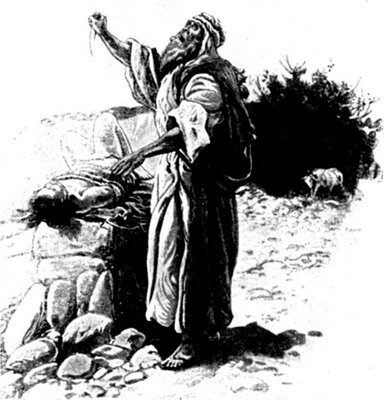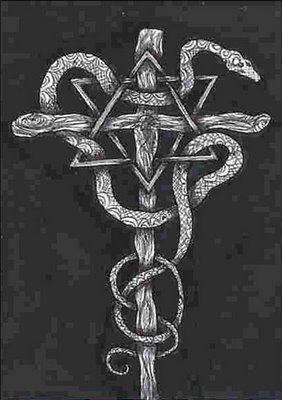All the prophets prophesied
only of the days of the Messiah
-Talmud-Sanhedrin 99a
Isaac and the Future Sacrifice (continued):
The event involving Abraham and Issac is called the aqedah. Jewish author Philip Segal writes,
Two concepts of Judaic theology emerge from the story of the aqedah: vicarious atonement and the suffering of the righteous. Both are impenetrable mysteries, and both are illustrated by the prophetic portion of the Bible that speaks of a suffering servant of Yhwh (Isa. 53).1
Note that he ties the aqedah with the suffering servant of Isaiah 53.
Pesikta Rabbati 40:6,
What is meant by Moriah? R. Simeon ben Yohai said: It is the Land which, if it were an arrow, would shoot up through the heavens directly to the heavenly altar. Here the world is derived from the stem shot through (yrh) (Exod. 19:13).
Midrash Rabbah-Genesis LVI: 3 commenting of Genesis 22:6,
“AND ABRAHAM TOOK THE WOOD OF THE BURNT-OFFERING (XXII, 6)-like one who carries his stake on his shoulder.
Footnote: “The stake on which he is to be executed.”
Concerning the suffering servant of Isaiah 42, 49, 50, 52, 53, Raphael Patai; Noted anthropologist and Biblical scholar who taught Hebrew at the Hebrew University of Jerusalem writes:
The Aggada, the Talmudic legend, unhesitatingly identifies him with the Messiah, and understands especially the descriptions of his sufferings as referring to Messiah ben Joseph.”2
The Torah: A Modern Commentary states,
There was…a remarkable tradition that insisted that Abraham completed the sacrifice and that afterward Isaac was miraculously revived…According to this haggadah, Abraham slew his son, burnt his victim, and the ashes remain as a stored-up merit and atonement for Israel in all generations.”3
Encyclopedia Judaica 2:482,
Ibn Ezra (commentary on Gen. 22:19) also quotes an opinion that Abraham actually did kill Isaac…and he was later resurrected from the dead. Ibn Ezra rejects this as completely contrary to the biblical text. Shalom Spiegel has demonstrated, however, that such views enjoyed a wide circulation and occasionally found expression in medieval writings.
Henry H. Halley wrote,
A Father Offering His Son: the Son, for Three Days, in the Father’s Mind, as good as Dead (22:4): a Substituary Sacrifice (22:13): and it was on Mount Moriah (22:2), same mount on which Jesus was Crucified, same place where Abraham had paid tithes to Melchizedek (14:18), Salem being on Mount Moriah. As Melchizedek seems to have been a primeval Shadow, in Abraham’s Life, of the PERSON Abraham’s Nation would bring into the world, so here seems to be a Shadow of the EVENT in the Coming Person’s Life by which He would do His work. What an apt Picture of the Death and Resurrection of Christ!”4

The Serpent in the Wilderness and the Lifting Up of the Messiah:
Jesus said,
And just as Moses lifted up the serpent in the wilderness, so must the Son of Man be lifted up, that whoever believes in Him may have eternal life (John 3:14).
After the Exodus from Egypt the people of Israel, yet again, complained against Moses and against God so God sent poisonous serpents among them and many of them died (see Numbers 21). When the people repented God told Moses to make a serpent out of brass and raise it up on a pole and that whoever looked to it would be healed.
Of course, looking at a twisted piece of metal had nothing to do with it; the point was to turn the people’s attention back to God, so that He would forgive them and heal them. In the scripture brass is symbolic of judgment and the serpent is symbolic of sin. God told Moses to make a serpent out of brass and lift it up to demonstrate that the people were being judged for their sin and that God forgives.
This is why Jesus said that in the same way Moses lifted up the serpent in the wilderness He too would be lifted up and Jesus certainly was lifted up on the cross in the same way and for the same reason as the serpent; in order to demonstrate the judgment for sin and the forgiveness and salvation. This is one of many ways that the Old Testament points us to the Messiah through symbolism.
Can you imagine dying a terribly painful death by snake venom just because you were not willing to follow the simple instruction of looking up? Jesus once cried out,
Jerusalem, Jerusalem, the one who kills the prophets and stones those who are sent to her how often I’ve wanted to gather your children together, just as a hen gathers her chicks under her wings, but you were not willing (Matthew 23:37).
Unwilling to simply look up.
Abraham Cohen; Editor of the Soncino Books of the Bible and participated in the Soncino translation of the Talmud and Midrash,
“Could the image of the serpent kill or save life? But the Israelites kept looking at it and believing in Him Who commanded Moses to act thus, and the Holy One, blessed be He, performed a cure for them.”5

